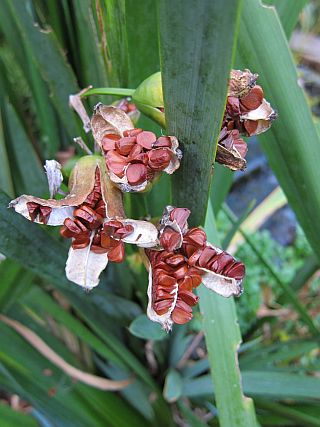I think I’ll stay on the invasive species track. And in honor of finals week, here’s a wee quiz for you.
1) What do we have here?*

hint – it’s a naughty plant
2) Why can’t federal/state designations be somewhat uniform?**
Exempli gratia:
“[This plant] is listed by the U.S. federal government or a state…" – USDA Plants Database
Connecticut: Invasive, banned
Massachusetts: Prohibited
Montana: Category 3 noxious weed
New Hampshire: Prohibited invasive Species
Oregon: "B" designated weed; Quarantine
Washington: Class C noxious weed
*scroll down for answers…
[scroll]
[scroll]
[scroll]
[a bit more]
* Iris pseudacorus. Yellow flag iris. Loves wetlands. Spreads like crazy via rhizomes and seeds. Possible inspiration for the fleur-de-lis.
** I don’t know. It’s very confusing. "Banned" seems more alarming than "prohibited", I suppose. Is "B designated" less a concern than "Class C"? Feel free to weigh in.
I live in Oregon and I have no idea what a “B designated weed” is, nor what I should do about it if I should find one. Quarantine? does that mean I should fence it off? Dig it up and put it in a pot in a dark room, away from other plants?
Actually, if a plant is designated “banned”, does that mean “banned from sales” or that you can be cited if it’s found to be growing on your property? And to whom are these missives directed–who keeps themselves informed? Once in a while I read an article in the newspaper about an invasive species (when it’s a slow news day, probably); otherwise, I’m not really making an effort to update myself on invasive plant species. Seems like a Sisyphean task to me.
I was about to write very similar comments specific
to the CT classification: “banned” from sale, from possession, from propigation? How are we to know? What are the proper steps to take once we know a plant is banned?
Yes, it’s hard to understand weed classifications. Well known to me is that plants behave so differently in different conditions. My garden is in a wooded area so I am cautious of spreading unwanted species to grow undisturbed but I’m on my own.
Can you say anything about ‘Bittersweet vine'(Celastrus orbiculatus or C. scandens)?
This year I have seen seedlings of it all over my property and in other gardens 4 & 5 miles away. It is impossible to kill – and impossible to know whether it’s the American or the Japanese. Clues are too subtle.
Thanks.
Berberis is banned in CT too – yet I see it in nurseries and big box stores all the time. It drives me crazy!
Anne and Emily – I’m with you. Shira, I think I wrote something a while back along those lines – why on earth?!! Same thing with variegated ligustrum. Chris, will have to look into Celastrus for ya.
Both Scotch broom & pampas grass are rated as “high” risk – meaning they have “sever ecological impacts” – for my area of California … but you can walk into most nurseries in the area and walk out with a five-gallon pot of them. Nursery employees just look at you with a “so does that mean you aren’t going to buy it?” face when you tell them it’s on the list. That’s where the consumers’ education starts
I was so happy that I actually identified this…but that’s because I planted it in my backyard. I live in a hot, dry part of CO, and researched the plant ahead of time. I learned that it was invasive in wetland areas, which isn’t a problem here. I mail-ordered the iris, the catalog didn’t mention anything about it being invasive or banned. I wonder if I broke the law by buying it or if they broke the law by selling it to me? It is thriving, and not trying to spread, in a corner of the yard that tends to be boggy from watering. Since the guidelines aren’t clear or enforced I thought that making sure I wasn’t planting anything that would be invasive in the conditions I intend to give it would be sufficient?
Jessica, fewer and fewer nurseries are carrying it. Restrictions and designations such as “noxious weed” or whatever are strictly on a state-by-state basis for most plants. I don’t recall ever seeing it listed for CO; as you noted, hot and dry makes it much less likely to spread.